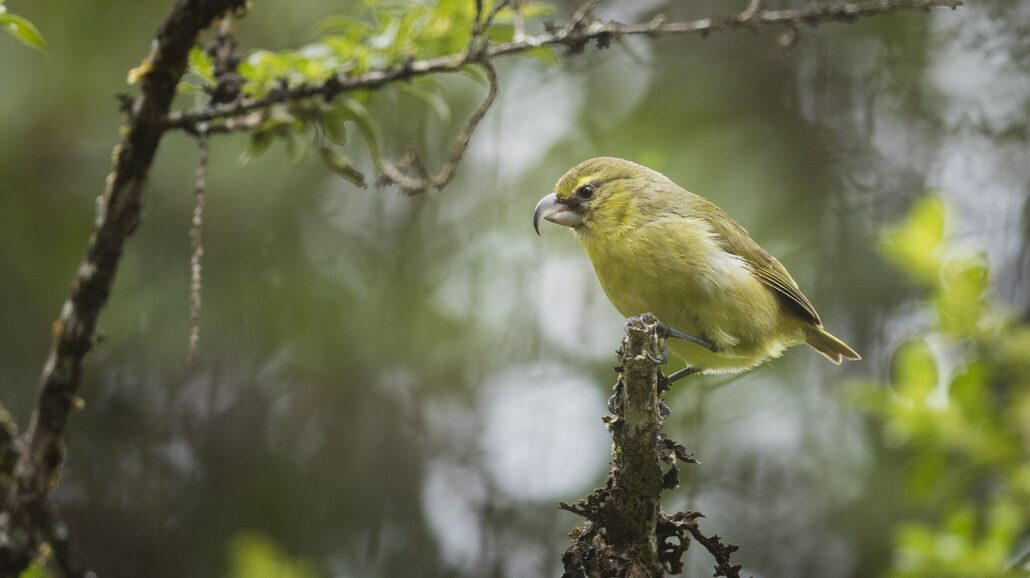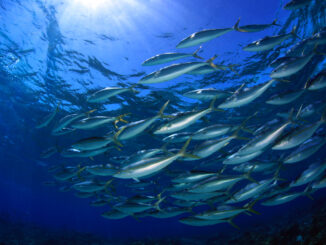
In an award-winning seven-minute video, Haleakala National Park biologist Christopher Warren starkly lays out what’s at stake for some of Maui’s last surviving bird species.
“We know there are fewer than 200 kiwikiu left in the world,” he said. “This is an ongoing extinction event.”
Now, a plan hatched in 2023 by Warren and others to save two of Maui’s endemic bird species, honeycreepers, is rolling out in earnest with a fresh infusion of cash.
The United States Department of the Interior recently announced it is directing $195 million to America’s national parks as part of President Joe Biden’s “Investing in America agenda for climate restoration and resilience projects.” Of the 40 projects slated to receive this money, a bid to save Maui’s critically endangered birds is one of them.
DOI says a portion of the $195 million spending plan is earmarked to “prevent the extinction of Hawaiian forest birds using innovated technology to suppress the population of non-native mosquitos in key habitats of East Maui.”
The National Park Service says $4.2 million will be directed toward saving Haleakala National Park’s endangered honeycreepers.
Honeycreepers are a genera of bird species known for their colorful plumage and curved beaks. Their beaks are curved because Honeycreepers co-evolved with species of flowering plants. They use their curved beaks to feed on the flowers’ nectar, capturing pollen on their feathers in the process and pollinating plants as they feed.
Two species of honeycreepers endemic to Maui—the Akohekohe and the kiwikiu—are listed as critically endangered. NPS says fewer than 2,000 Akohekohe are surviving. As Warren indicated in the video, kiwikiu are on the verge of extinction.
An invasion of non-native mosquitoes introduced a deadly strain of avian malaria that has laid waste to Maui’s birds, especially these honeycreepers. The disease has a roughly 95 percent fatality rate in honeycreepers, Warren said.
Today, researchers say they have to venture to Haleakala’s higher elevations to find the critically endangered birds, 6,500 feet (almost 2,000 meters) or higher, where the mosquitoes won’t reach them.
With these bird populations at such critically low levels, NPS and its partners fear they only have about two years to save the species from extinction.
Their plan to save the Akohekohe and the kiwikiu is called the “Incompatible Insect Technique” or IIT.
Through IIT, wildlife managers release populations of “incompatible” male mosquitoes into the wild. These male mosquitoes don’t bite, but they mate with species of female mosquitoes that do. It’s the female mosquitoes that are responsible for the spread of avian malaria.
The males are deemed “incompatible” because their mating with females results in non-viable offspring—eggs that never hatch. The female mosquitoes can only breed once. The hope is that the non-viable males will “outcompete” the viable ones in mating with the disease-spreading females in the wild.
Over successive generations, the mosquito population should fall, reducing the incidence of avian malaria in the process and giving space for bird populations to grow.
“The female mosquito has one chance to successfully choose a mate,” NPS explains in an overview of the plan. “If she mates with an incompatible male, she has lost that chance to introduce new mosquitoes into the wild.”
Thus, as NPS continues, “The repeated process of wild females mating with incompatible males successfully decreases the southern house mosquitoes.”
NPS, in partnership with the US Fish and Wildlife Service, the Nature Conservancy, and Hawaii’s Department of Land and Natural Resources, plans to release populations of non-viable males at known mosquito breeding grounds in Haleakala and other parts of eastern Maui using drones or other means. Releases need to be timed and spaced apart strategically to improve the incompatible males’ chances of outcompeting viable males.
Parts of the island where honeycreepers are believed to face acute threats from mosquitoes will be prioritized.
“These birds are only found on this island,” Warren said. “Controlling mosquitoes is the only hope.”
©2025 Public Parks
Park Info
Park Name:
Haleakala National Park
Location:
Hawaii, USA
More Information:



